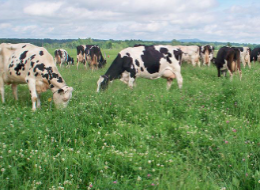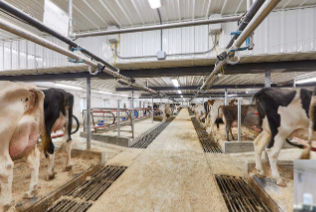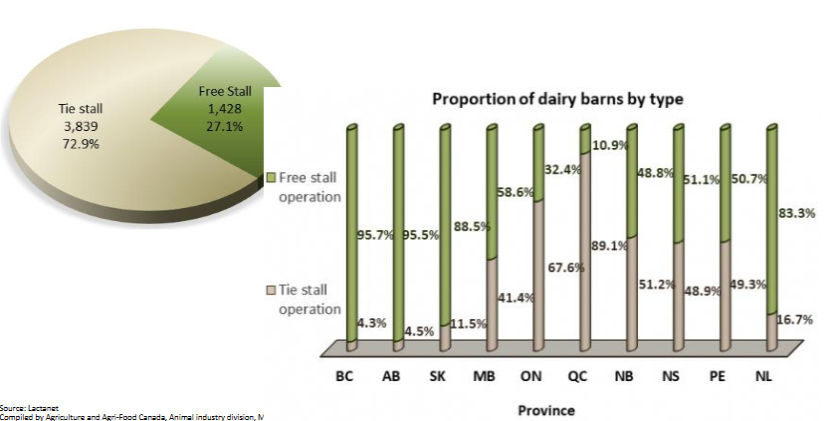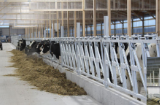🏠 Lecture 8: Dairy Housing
1/14
There's no tags or description
Looks like no tags are added yet.
Name | Mastery | Learn | Test | Matching | Spaced |
|---|
No study sessions yet.
15 Terms
Group Maternity Pen vs Individual Maternity Pen
Often influenced by space constraints
Housing During Transition Period - Prepartum
Close-up pen
Pen for prepartum cows
Cows moved to pen ~3 weeks before calving
Maternity/calving pen
Pen for prepartum cows few days/hours before calving
Sometimes producers move cows only when calving process begins
“Just in time management”
Group or individual pens
Sometimes closeup and maternity pens are combined (space constraints)
Do Cows Prefer to Calve in Private?
We hypothesized that indoor-housed cows are motivated to seek seclusion from herdmates (and other perceived threats) and will use a 'hide' if given the choice
The results of our preference tests indicate that even modern, indoor-housed dairy cows are looking for a secluded place to calve, perhaps especially in busy barns and during busy times of the day
Housing During Transition Period - Fresh
Fresh pen
Pen for postpartum fresh cows
Cows may stay for 1-21 days after calving, then move pens
Free choice hay sometimes offered
Sometimes housed with hospital cows
Not all farms do this, sometimes cows enter main lactation pen immediately
Grouping Cows Throughout Lactation
Helps to better manage cows
Feed diets based on different needs
Helps keep an eye on fresh cows
Grouped by:
Stage of lactation
Fresh
Early Lactation
Mid-lactation
Late lactation
Parity
Primiparous
Multiparous
Milk production
High yielding
Low yielding
Types of Dairy Systems
PTFD - Stalls are more common in Canada
Pasture
Drylot
Tie-stall
One of main systems in Canada
Free stall
One of main systems in Canada
Pasture
Not common in Canada
Short grazing season in Canada
Canada is cold
Canadian organic farms require pasture access
High milk production in Canadian cows
Energy demands not met by pasture alone
Common in Australia + New Zealand
Most cows supplemented with concentrate (grain and premix) or PMR (partial mixed ration) in milking parlor or shade pad
Cows live in pasture and walk to milking parlor

Drylot
Not typical in Canada
Popular in SW USA
Land must be “dry”
Cows housed in large outdoor pens/corrals
Shade shelters, fans, misters usually included in pens

Tie-Stall/Pipeline
Cows are tied to stalls
Cows eat, sleep, are milked in stalls
Cows go outside during day for exercise/free time
Most common system in Canada (mostly in Eastern provinces)

Barn Types in Canada
73% tie stall (mostly Eastern provinces, ON, QC, etc.)
27% free stall (mostly Western provinces, BC, AB, etc.)

Tie-Stall/Pipeline Advantages vs. Disadvantages
Advantages
Individualized cow monitoring + management
No competition for food/water
Individual cow space
Improved sanitation
Disadvantages
Less exercise
Less socialization
Stall sanitation must be managed
Lots of work for milkers
Heat detection may be harder
Negative public opinion
Tie-Stall/Pipeline Phase Out
Effective April 2027, cows must not be tethered continuously
Cows must be provided sufficient regular opportunity for freedom of movement to promote good welfare
Currently debated whether or not tie-stalls meet this criteria
Free-Stall
Cows aren’t tethered to stalls, free to wander around barn
Cows walk to milking parlor
Pens made up of stalls for resting and feed alleys for eating

Free-Stall Advantages vs. Disadvantages
Advantages
Unrestricted, free movement of cows
Improved heat detection
More cow exercise
More cow socialization
Disadvantages
Food/water competition
Cow hierarchy, “boss” cows
Decreases resting and eating time for cows
Less milk production
More cow-cow disease transmission
More injuries
Barn Design Considerations
Type of bedding in stalls
Stall design
Stocking density
Ventilation
Heating/cooling
Feed/water locations